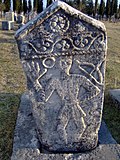Žitomislić Monastery
| Žitomislić Monastery | |
|---|---|
Манастир Житомислић | |
 | |
| Religion | |
| Affiliation | Serbian Orthodox |
| Rite | Eastern Orthodox |
| Ecclesiastical or organizational status | Eparchy of Zahumlje and Herzegovina |
| Patron | Annunciation |
| Year consecrated | between 1602/1603 and 1609 |
| Location | |
| Location | Žitomislić |
| Municipality | Mostar |
| State | Bosnia and Herzegovina |
| Geographic coordinates | 43°12′17″N 17°47′38″E / 43.204628278225144°N 17.79378609519168°E |
| Architecture | |
| Founder | Duke Petar and Jovan Hrabren |
| Groundbreaking | 1556 |
| Completed | 16th century |
| Materials | stone |
| Designated as NHL | |
| Official name | Monastery Žitomislić, the historic site |
| Type | Category I cultural and historical property |
| Criteria | A, B, C iv.v., D ii.v., E ii.iii.iv.v., F, G i.iii.iv.vi., I. |
| Designated | 6 November 2002 (- th session; decision No.01-279/02) |
| Reference no. | 1815 |
| List of National Monuments of Bosnia and Herzegovina | |
| Website | |
| website | |
 | |
The Žitomislić Monastery (Serbian: Манастир Житомислић, Manastir Žitomislić, pronounced [ʒitǒmislit͜ɕ]) is а Serbian Orthodox monastery dedicated to the Annunciation and located near Mostar, Bosnia and Herzegovina.
History
[edit]Building
[edit]In 1566 the Ottoman Empire, as represented by the kadija (qadi) in Nevesinje, granted the Miloradović-Hrabren family a permit to build monastery at Žitomislić over the ruins of an older church. The monastery took more than forty years to complete with the first reference to monks at Žitomislić in 1606.[citation needed] The monastery boasted a highly artistic iconostasis, and housed a scriptorium of considerable activity and renown in its time. At the height of its existence the monastery was supported by large land holdings worked by the monks themselves.[citation needed]
Modern history
[edit]
Early in the 19th century, the prior, Simeon Miljković, took on improvements to the monastery that included guest quarters, local water, and a new vineyard. A seminary was opened in 1858. The entire brotherhood of Žitomislić monastery was arrested by the Croatian fascist Ustasha on 26 June 1941, and driven to the village of Blizanci, where they were tortured and killed, some being thrown alive into the Vidonja cave-pit.[1]
The monastery was plundered and the entire compound was destroyed with the sole exception of the monastery church. The bodies of the monks were recovered from the pit in 1990 and buried on 3 February 1991, with Serbian Patriarch Pavle (Paul) officiating at the service.[2]
In 1992, Žitomislić was destroyed by the Croatian Defence Council (HVO) as part of the ongoing warfare after the collapse of Yugoslavia.[3]
At that time the library contained dozens of old manuscripts from the 16th and 17th centuries including a small archive of Turkish documents. The treasury was plundered and the buildings, including the cemetery were dynamited and bulldozed to the ground. The stones were left where they fell, however, and when reconstruction of Žitomislić officially began in April 2002, its prior architecture was meticulously reconstructed. In May 2005, the regular session of the Holy Assembly of Bishops of the Serbian Orthodox Church began in the fully restored Žitomislić Monastery.[4]
See also
[edit]References
[edit]- ^ Pištalo, Borivoje, ed. (2001). Srbi u Mostaru. Belgrade: Svet knjige. pp. 281–299. ISBN 86-7396-026-6.
- ^ "Žitomislić monastery". Eparchy of Zahumlje and Herzegovina. Retrieved 4 September 2017.
- ^ Halilovich, Hariz (February 2013). Places of Pain. Berghahn Books. ISBN 9780857457776.
- ^ "Žitomislić monastery". Eparchy of Zahumlje and Herzegovina. Retrieved 4 September 2017.
External links
[edit]- Official page (in Serbian)
- znanje.org (in Serbian)
- Buildings and structures in Mostar
- Churches completed in 1606
- 16th-century Serbian Orthodox church buildings
- Christian monasteries established in the 16th century
- Serbian Orthodox monasteries in Bosnia and Herzegovina
- Attacks on churches in Europe
- Ustaše
- National Monuments of Bosnia and Herzegovina
- Attacks on religious buildings and structures during the Bosnian War
- 16th-century establishments in Bosnia and Herzegovina
- Attacks on religious buildings and structures during World War II
- Anti-Christian sentiment in Europe











